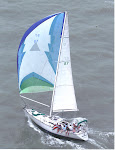White Pepper made
it to the travel lift safely and was hauled and blocked in the work
yard of Green Cove Springs Marina. This marina is DIY (do it yourself) boatyard and one of the few such in Florida. We were able to stay aboard and
work on the boat. We caught a break with the weather as an
unseasonable spell of cool and dry air made for pleasant working
conditions. Usually at this time of year northern Florida is a
misery. .Living aboard was pleasant enough with cool nights. The
days were always busy with noisy activity everywhere. The only
aggravation was having to climb down the ladder to go to the head.
Jan
varnished the bright work to perfection. She also waxed the metal
stanchions and winches. She completely cleaned the interior with
vinegar and furniture wax. I compounded and waxed the hull which took
four days. We installed an oil lamp on the port bulkhead.
Also
I cleaned and greased all of the winches. I have posted previously
about the amazing Barient 726's which are White Pepper's
primary winches. What I did not post was that I had lost the low
gear on the port side to corrosion last fall. We no longer need low
gear as we no longer have to grind in a large genoa in a breeze.
But still I felt responsible. These old winches are museum
pieces—relics of an older and perhaps better era of sailing in the
1960's and 70's. I took the rusted piece and soaked it overnight in
acetone and ATF fluid. I bought a propane torch and heated it.
Marvelous flames of burning ATF came out of the gear. Finally, I
took that most delicate of tools, the ball peen hammer, and whacked
it hard 4 or 5 times. It moved! Ten more whacks and the pieces were
freed. Then I sanded and cleaned the gear for hours. I had
purchased new paws for the gears. Despite the promise of a universal
fit, the paws were too fat and too short for the ancient gear. New
springs and new high tech Teflon grease finally got the paws to work
again. Originally, I had imagined that if I succeeded in reviving the
gear my joy would be unbounded. However, with success I felt more
relief and anxiety than joy. The gear had failed more because of
lack of use than anything else. I would have to deliberately
exercise the winch regularly from now on.
Other
chores included replacing a failed battery selector switch. We
negotiated a deal with Yanmar to purchase a new motor. This will
hopefully happen in 3 or 4 weeks. We ordered new lifelines from Julian at Sparcraft. Both of the upper life lines had parted on the cruise.
We changed the zincs on the keel cooler of the FrigiBoat refrigerator. I serviced the anchor windlass. It was frozen and also needed the ball peen hammer treatment. I exchanged the primary and secondary chains on the bow. Also I shortened the secondary chain from 100 feet to 40 feet. This will remove 100 pounds from the bow. In October I will ask Julian to redo the chain to rope splice.
We changed the zincs on the keel cooler of the FrigiBoat refrigerator. I serviced the anchor windlass. It was frozen and also needed the ball peen hammer treatment. I exchanged the primary and secondary chains on the bow. Also I shortened the secondary chain from 100 feet to 40 feet. This will remove 100 pounds from the bow. In October I will ask Julian to redo the chain to rope splice.
Finally,
we have run out of time and have to leave for Texas. Many more
chores remain to be done. Re bedding the windows to prevent leaks
which should take about a week, re bedding the mast step, replacing
the rudder which is leaking, and replacing the potty with a
composting head. The hot water heater was damaged with the
overheating and needs service. Of course the bottom needs to be
sanded and painted with antifoulant. We will do these chores in
October before heading out again for another adventure


